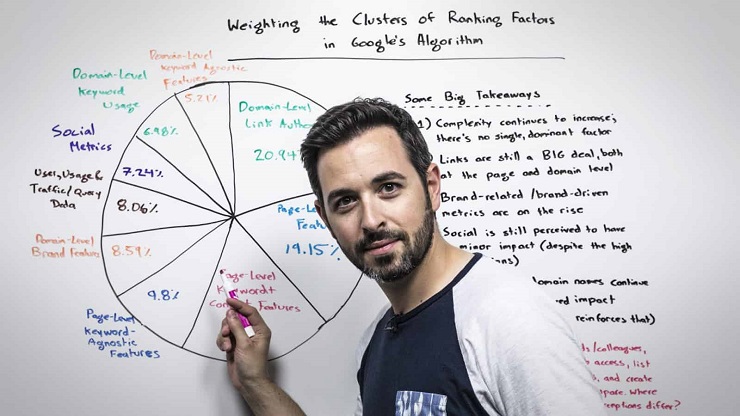Riddle me this. What’s the one marketing tactic that gives your brand lots of personality, sets you (far) apart from your competition, and connects with your audience at any point in the sales funnel?
The answer is video.
Video content is skyrocketing in popularity and effectiveness. Social media is making it easier to produce and share video. Left and right, new software programs are popping up that are designed solely to manage and leverage video content.
In fact, Cisco predicts that video will make up almost 80% of all internet content by 2020.
With increased tablet and mobile use, streaming services, and the rise of video content performance on social media, this shouldn’t come as a surprise.
And yet, video is also the medium that many entrepreneurs and small businesses neglect to leverage in their marketing efforts. Whether they’re held back by small budgets, time constraints, or a lack of on-screen talent, these companies don’t see a place for such content in their strategy.
They couldn’t be more wrong.
Why You Need Video in Your Marketing Strategy—Yes, You
Video is quickly becoming the most powerful medium in marketing. In fact, over 50% of marketers worldwide name video as the type of content with the highest ROI.
Among all types of marketing content, visual content performs best. And among all visual content (such as images, infographics, etc.), video is the most powerful.
One clear reason is that visual content is inherently more shareable than written content. While a visitor may take the time to read your blog and not consider sharing it, a clever image or entertaining video can send them darting for the “Share” button.
When we talk about shares, we’re referring to a visitor organically posting about your content, such as copying and posting the URL or sharing to social media directly from your YouTube page or blog. Although the topic is still up for debate, internal social shares (e.g. Facebook shares, retweets, and repins) don’t contribute to your website’s overall ranking in search results.
Shareable content is a terrific way to create backlinks (inbound or incoming links) to your site, which in turn improves how high your website ranks
in search engine results. Backlinks tell the search engine that your website is popular and valuable to others and will rank it as such.
In short, sharable content = better SEO.
Second, visual content leaves more “room” for your brand to engage each viewer. Keeping a reader engaged with a blog post is tough (hey, pay attention!), so much of the effort in creating it goes toward making the content itself engaging and fast-moving enough to keep people sticking with it. With video and images, on the other hand, that limited attention span is much easier to engage. People are more naturally drawn to it. That leaves you with more time to engage them in other ways, say, nudging them further down the path to purchase.
In terms of website traffic, it’s been proven that website visitors spend 100% more time on pages with videos. Online shoppers are also 64-85% more likely to purchase an item after watching a product video.
Finally, video content brings your brand the most value. Providing a wide variety of content for your audience is the best way to reach and convert them. Videos may take more time and money to produce, but considering how many ways they can be repurposed, they’re the content gift that keeps on giving.
How Video Boosts Your Brand
Video content can do a couple things for your brand. On one hand, well-produced video can further the legitimacy and stature. It can say to your audience, “We take ourselves seriously, and we invest in high-quality ways to connect with our audience.” A pleasant aesthetic can go a long way in communicating value and seriousness.
If you’re looking for ways to make your brand seem bigger than it really is, consider increasing your video budget.
On the other hand, “casually” produced video (think live video or on-the-fly recordings on social media) can make your brand seem more personable and down to earth. If you’re looking for new ways to meet your audience where they are and stand out among competition, consider establishing or increasing your video presence on social media.
Regardless of how you’d like to leverage video, you must consider a strategy for how to use it.
Unfortunately, many businesses neglect to include video content in their brand strategies, leaving creation and distribution to the wind. That creates a gap in your overall brand strategy, meaning that poorly considered use of video can do more harm than good. If you’ve worked to clearly define your brand (which you should!), ensure that video isn’t left out of that definition.
Building a Video Strategy That Works For You
If you’re dragged your feet when it comes to getting into video marketing, I’ll bet it’s because you think it’s too difficult. Too time-consuming, too resource-intensive. It requires some kind of talent or skill you just don’t have.
If so, I have fantastic news for you.
Video marketing is easier than ever, and bordering on being just plain easy. It requires far less labor and marketing investment than in previous years. But, regardless of its simplicity, video—just like every other piece of your marketing strategy—should be planned and practiced before production.
As you strategize how, when, and where video content will be worked into your marketing strategy, first ask yourself and your team these questions.
Who’s your audience?
Ah, the question that all marketers should be able to answer in their sleep.
Defining your audience is critical to figuring out how, where, and why your video content is to be created and shared.
Where does your audience hang out online? What content would resonate with them? How are they using your product, and how can you help them do it better? Determine these answers before anything else. They may dictate your responses to the rest of your strategy.
What story do you want to tell?
To answer this, return to heart of your brand. The story that you’re telling through advertisements, social media, blogging, and your website should be the same one you strive to tell on video.
Whether you’re capturing a live recording of a recipe or interviewing your most gung ho employees, make sure your video stays within the lines of your brand story.
Video content—more so than any written copy—is a great way to give your company personality and character. It also makes it easier to give the wrong impression, and one that sticks. Don’t forget that as you map out your next production.
What outcomes are you seeking?
Are you looking to boost your Instagram engagement? Are you trying to ease your customer experience? Is your goal to increase website conversions?
Before you begin, jot down your endgame. This will not only help you determine video topics and stay on track during production, but it will also remind you to leave the door open for viewer feedback and questions.
Like we said above, you always want to ensure your content is resonating with your audience.
What’s your call to action?
This will vary from video to video, but a call to action should be included in every one. If you’ve got your audience hooked for a minute or two, don’t fade to black without engaging them in some way.
Video that speaks to your company or product in any way should be integrated into your lead funnel. Casual or live video on social media should at least ask for a follow, comment, or a website click.
Repeat your call to action in the video’s caption or post content.
What resources do you have?
Your resources will dictate what kinds of videos you can make and where you’re able to post them.
For video content that you’ll use on social media, a smartphone should suffice. For many of you, this is square one and a great way to dip a toe into video marketing. Smartphones have also come a long way in terms of image quality and editing, so you can actually come up with some pretty slick stuff using just what’s in your pocket.
If you’re looking to produce something more professional-looking, a video that stands up on YouTube or embedded on your website, for example (especially video that you hope will be shared), there are a few ways you can do so.
- If you want to make your video in-house, you’ll likely want some basic filming equipment. That means a digital camera for starters, but potentially some studio lights, a tripod, and wireless microphones. You can always invest in more professional equipment once you’ve successfully integrated video into your marketing strategy.
- If you don’t want to create your own videos but still want to film your product and/or people (and still hit your budget), look into hiring a local production company. Across the world there are thousands of small teams that simply love creating good video. Start local if you want to hire out your video production. Take a look at each company’s highlight reel to get a feel for their work aesthetic and ensure it falls in line your brand’s ethos.
- If you want to build a great video without actually capturing footage (it’s possible!), consider purchasing stock footage and music and investing in good copywriting instead. Sites like FilmSupply and AudioJungle offer high-quality stock media at decent prices. (It’s none of that cheesy video clips – we promise!) Instead of paying to capture video, find a few clips that tell the story you want. Hire a copywriter to script your story, and bring in a motion designer to digitally render your product so it still plays a role in your video. This avenue works really well for software companies, as their entire product offering already lives on the screen.
Lastly, your resources will also dictate how often you can produce video. Just as with email marketing, podcasting, and blogging, consistency is key. For example, if you plan to release video blogs, or short videos with customer testimonials, sticking to a consistent schedule gives you a huge leg up. Your audience will come to anticipate videos; releasing them on an irregular schedule may cause them to lose interest.
There’s already enough video content vying for your audience’s attention online, so a focus on quality and consistency will help you stand out.
Making Meaningful Videos
Regardless of your industry, audience, company size, manpower, product offering, or budget, video can benefit your business. And considering today’s technological availability and improvements, you really have no excuse when it comes to implementing some type of video.
If you’re with me this far, you may soon find yourself staring blankly at that intimidating, big red record button.
That’s because, budgeting and production aside, drumming up video topics is the main thing that marketers struggle with.
If you’ve yet to sketch out a brand strategy per our questions above, go ahead and do so. Outlining your responses to those questions should help you figure out a few topics to start with.
Otherwise, here are some other ideas for video content that will likely be meaningful to your audience and brand.
Customer-centric
Client and customer reviews are powerful forms of user-generated content. Potential customers trust authentic reviews over company-created content by a longshot. Now, imagine that you captured your testimonials on camera. How much more effective would that content be if it was delivered straight from the source?
Leveraging this type of social proof via video not only plays on the emotional connection of seeing someone’s face and hearing their voice, but it also helps to bolster the trust created through word-of-mouth marketing. Video testimonials can bypass skepticism and immediately build credibility, even with a consumer who’s never heard of your business.
Check out how graphic design company 99designs features their customer stories.
Industry or company-centric
Now let’s turn the camera around.
Look inside your organization for interview opportunities. Put a human face to your company by showcasing conversations with employees and the leadership team. This is a great way to build and maintain your brand personality, and will give your audience an idea of who’s working on that product or service they love so much.
Consider recording live video while working with your team and posting it to social media. Showcasing company culture online is a great way to break up product-related posts while also boosting your recruitment efforts.
Hubspot provides a great example of using video to show company culture. They dedicate a whole page to their employees and careers.
You can also use video to expand on your industry as a whole. If you populate your current blog, website, or newsletter with information from industry leaders, supply chain partners, or associate companies, turn these written interviews into video. Including others in your industry will provide your audience with a different perspective beyond what you can provide. It will also encourage the person you’re interviewing to share your video, helping you reach a wider audience.
Regardless of whom you’re talking with, video interviews always have a more conversational tone compared to the back-and-forth of written ones.
Product-centric
Video that showcases your product or service is always effective. Any effort to enhance and/or ease your customer experience will be viewed favorably in the eyes of your customers. Many companies create an animated introduction video to summarize their product offering as a whole
You Need a Budget (YNAB) offers on their homepage a video providing a high-level explanation of their software. Sometimes, a quality video like this can initiate the lead-conversion process better than any demo or sales call.
One way of doing this is creating how-to videos that answer questions previously posed by customers. Not only does this tell your customers that you’re listening and willing to help, but it also makes your customer service more interactive. Use video to provide proactive customer service. Your customer service team will thank you.
Another way to focus your videos on your products is to film them in action. Similar to a video testimonial, record your team or customers using your product or service. This type of content will complement your professional photography and video and give your audience a taste of your product in action. Better yet, ask your customers to send in user-generated video for you to share on your social channels.
Knowledge-centric
One of the most effective ways to establish your business as a knowledgeable, reliable leader in your industry is to focus your content on educating your audience—not simply selling to them.
Consider Moz’s Whiteboard Fridays.
Rand Fishkin started these as the company was being founded, and now thousands of people turn to these for new knowledge. (In fact, “Whiteboard Friday” is a now common term in the SEO community.)
And because Moz has proven itself as a leader in the digital marketing space, many people have come to rely on their software and products. Video can be a great lead source.
Conclusion
Video is the one marketing tactic that can give your brand loads of personality, set you far apart from any competition, and connect with your audience better than any other medium. Regardless of your budget, time, or team, video can work for you—if it falls in line with your brand strategy.
Between on-screen testimonials, filmed FAQs, live shots of company culture, and educational videos, video content can click with your audience no matter where they are in the sales funnel. So get on it!
Got a favorite example of a company using video marketing? Any questions I can answer on video marketing? Tell us in the comments below!























